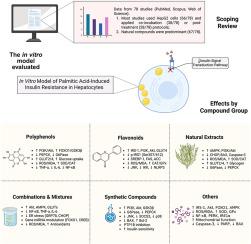Palmitate-induced hepatic insulin resistance as an in vitro model for natural and synthetic drug screening: A scoping review of therapeutic candidates and mechanisms
IF 5.4
2区 医学
Q1 BIOCHEMISTRY & MOLECULAR BIOLOGY
引用次数: 0
Abstract
Type 2 diabetes mellitus (T2DM) is a complex metabolic disorder characterized by insulin resistance (IR) and β-cell dysfunction, often exacerbated by excessive intake of saturated fatty acids, particularly palmitic acid (PA). As the most abundant saturated fatty acid in Western diets, PA contributes to metabolic dysregulation by inducing mitochondrial dysfunction, enhancing reactive oxygen species (ROS) generation, activating inflammatory pathways, and impairing insulin signaling in hepatocytes. Consequently, PA-induced hepatic IR has become a widely accepted in vitro model for investigating therapeutic strategies to restore insulin sensitivity. This scoping review aims to identify and summarize natural and synthetic compounds evaluated in this model, emphasizing mechanisms of action and highlighting research gaps. A total of 78 eligible studies were selected through a systematic search of PubMed, Scopus, and Web of Science. Most studies employed HepG2 cells and adopted co-incubation or post-treatment protocols to simulate preventive or therapeutic contexts. Natural compounds predominate, particularly polyphenols, flavonoids, alkaloids, and plant extracts. Reported mechanisms involved activation of insulin signaling pathways (phosphoinositide 3-kinase/protein kinase B [PI3K/Akt], adenosine monophosphate-activated protein kinase [AMPK]), attenuation of oxidative stress (reduced ROS and malondialdehyde [MDA], increased superoxide dismutase [SOD] and catalase [CAT]), inhibition of inflammatory mediators (tumor necrosis factor-alpha [TNF-α], interleukin-6 [IL-6], nuclear factor kappa B [NF-κB]), and regulation of apoptosis (caspase-3, Bcl-2-associated X protein/B-cell lymphoma 2 [BAX/Bcl-2]). Overall, this model provides a robust and translationally relevant platform for screening bioactive compounds targeting multiple pathological features of T2DM.

棕榈酸盐诱导的肝脏胰岛素抵抗作为天然和合成药物筛选的体外模型:对候选治疗药物和机制的范围审查
2型糖尿病(T2DM)是一种以胰岛素抵抗(IR)和β细胞功能障碍为特征的复杂代谢紊乱,通常因过量摄入饱和脂肪酸,特别是棕榈酸(PA)而加重。作为西方饮食中最丰富的饱和脂肪酸,PA通过诱导线粒体功能障碍、增强活性氧(ROS)的产生、激活炎症通路、损害肝细胞胰岛素信号通路等途径导致代谢失调。因此,pa诱导的肝脏IR已成为一种广泛接受的体外模型,用于研究恢复胰岛素敏感性的治疗策略。本综述旨在识别和总结在该模型中评估的天然和合成化合物,强调其作用机制并突出研究空白。通过系统检索PubMed、Scopus和Web of Science,共筛选出78项符合条件的研究。大多数研究使用HepG2细胞,并采用共孵育或后处理方案来模拟预防或治疗环境。天然化合物占主导地位,特别是多酚、类黄酮、生物碱和植物提取物。已报道的机制涉及胰岛素信号通路的激活(磷酸肌苷3-激酶/蛋白激酶B [PI3K/Akt],单磷酸腺苷活化蛋白激酶[AMPK]),氧化应激的衰减(ROS和丙二醛[MDA]的减少,超氧化物歧化酶[SOD]和过氧化氢酶[CAT]的增加),炎症介质(肿瘤坏死因子-α [TNF-α],白细胞介素-6 [IL-6],核因子κB [NF-κB])的抑制,以及细胞凋亡的调节(caspase-3,Bcl-2相关X蛋白/ b细胞淋巴瘤2 [BAX/Bcl-2])。总之,该模型为筛选针对T2DM多种病理特征的生物活性化合物提供了一个强大的、与翻译相关的平台。
本文章由计算机程序翻译,如有差异,请以英文原文为准。
求助全文
约1分钟内获得全文
求助全文
来源期刊
CiteScore
7.70
自引率
3.90%
发文量
410
审稿时长
36 days
期刊介绍:
Chemico-Biological Interactions publishes research reports and review articles that examine the molecular, cellular, and/or biochemical basis of toxicologically relevant outcomes. Special emphasis is placed on toxicological mechanisms associated with interactions between chemicals and biological systems. Outcomes may include all traditional endpoints caused by synthetic or naturally occurring chemicals, both in vivo and in vitro. Endpoints of interest include, but are not limited to carcinogenesis, mutagenesis, respiratory toxicology, neurotoxicology, reproductive and developmental toxicology, and immunotoxicology.

 求助内容:
求助内容: 应助结果提醒方式:
应助结果提醒方式:


